When you think of designing a referral program, you probably wonder if a referral program template exists. After all, there are many moving parts involved in a refer-a-friend program.
Is there really a tried-and-true method for creating an effective referral program, that you can glean from the most successful programs out there?
If you dive into how referral programs are structured, you’ll find that the best referral programs are very similar. Even though the design elements may differ, every referral program contains many of the same components – a referral program template.
Following this referral program template can help set your brand up for success.
Today, we’ll examine the various parts that make up the referral program template. In addition, we’ll show examples of how the template works for top brands, and discuss key template elements to making your program work in your favor.
Key factors for referral program success
The following factors are key to any high-performing referral program template. Use these elements as the basis for your own referral campaign.
A brand worth referring
This is the most important factor to have in place before starting a referral program. Even with all the other elements of your referral program template in place, people will only refer you if they are satisfied with your products and your customer service. After all, when someone recommends something to their friends, they put their reputation on the line (they don’t want to disappoint their peers).
Check reviews, comments, and customer satisfaction surveys to make sure people are happy with your brand. A strong base of happy customers means plenty of potential advocates.
A visible referral program
In order to achieve word-of-mouth growth through your referral marketing program, the program needs to be visible. It sounds simple, but this factor is easily overlooked.
Promote your referral program via email, on social media, on your website, and more. Images, clear buttons, and calls to action should all be in play with your referral program.
Motivating rewards
Satisfied customers usually still need an extra push before they refer their friends. And people new to your brand are more likely to make their first purchase when they stand to receive an extra benefit.
Thus, you’ll want to select motivating rewards for your referral program. Then, within your program design and promotions, make those incentives clear.
Your incentives should include:
- The extrinsic rewards you give customers when one of their friends makes a purchase
- The extrinsic rewards customers can send to their friends, to encourage the friends to purchase from you
- The intrinsic benefits to customers, such as the inherent rewards of helping a friend
A program that’s easy to join
Customers won’t work harder than they need to. Make it easy for your existing customers to refer others, and for your new customers to sign up. Taking out any potential hard work will make customers more willing to help you out (remember, they’re doing you a favor).
- People should be able to refer their friends in as few clicks or taps as possible.
- And don’t include too many boxes on your referral form, as too many questions can cause customers to give up on your referral program.
Multiple sharing options
The more options a customer has to invite friends and family members, the better the chances that they’ll share your brand with friends.
Choose several sharing options that reflect how your customers naturally communicate with their peers.
- Allow loyal customers to share via social media, email, text messaging, and more.
- And be sure to include a referral link, so customers can easily copy, paste, and share in the most convenient way for them.
Customer referral program templates: Focus on the two personas
When you design a customer referral program, you need to create a template that focuses on two personas. This will help both sides make and act on referrals through your new referral program.
There is the advocate (we’ll call this person “Anna”) and the referred friend (we’ll call this person “Rex.”)
Anna the advocate
Anna is the advocate, the person invited to join the referral program (asked to share your brand with friends).
- The advocate is sometimes called the existing customer, program member, or ambassador.
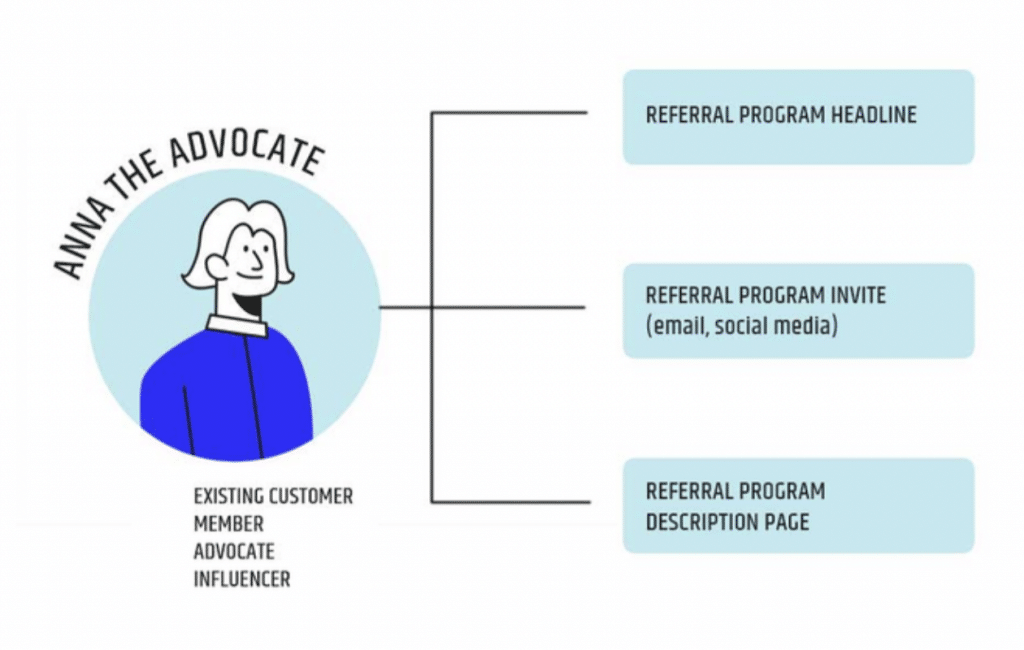
Anna will see:
Referral program headline
This is the first thing Anna will see about your program. It announces that a referral program is available and lets her know about its benefits. You can place it on a landing page, on an invite, or anywhere else you promote the program.
Referral program invite
Anna will get this invite to introduce her to the program. It can be sent via email or social media. The invite should tell Anna about the program, as well as what she can earn for joining and referring friends.
Referral landing page (or pop-up)
Next, Anna will see a pop-up or landing page for the referral program. This is where she can invite friends to check out your brand, via the referral program.
It should advertise referral rewards (what prize they get for purchasing or signing on with a brand).
The invite you send Anna should include a link directly to this page, so she can start making referrals right away.
Referral message template (sometimes)
In some cases, it’s best to provide a prewritten message to encourage the advocate, to send invites to their friends.
By creating this message for Anna, the pressure is off of her. But there should also be space where Anna can add to or adjust the message, to make it more personalized.
This message could be shared by email, social media. Anna doesn’t have to see the message, but Rex eventually will see it in the invite.
Rex the referred friend
Rex is the person that the advocate (Anna) shares your brand with, using the referral program.
- The referred friend is sometimes called the referral or lead.
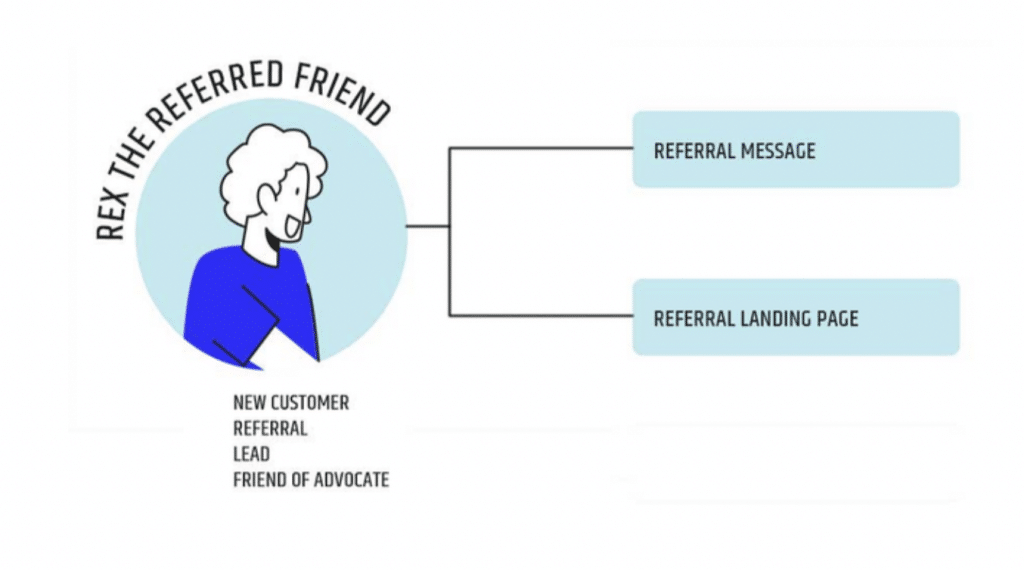
Rex will see:
Referral program message
The referral program message comes directly from Anna and invites Rex to check out your brand. It is meant to get Rex excited about your products or services.
It should have a conversational tone – even if your brand actually writes the message, it should sound like Anna wrote it.
Rex can receive this message via email, social media, or any other direct contact method.
Friend landing page
If Rex clicks the link in the referral program template message, it will take him to the friend landing page (the page meant for referred friends).
This page shares about your brand, and has the aim of convincing Rex to make a purchase. It should be informative, explain the reward incentive for a first purchase, and show why there is value in using your brand.
Like all landing pages, it’s designed to get Rex to sign up or start buying products.
5 essential components of a referral program template
You now know the two parties involved in the customer referral program template, what they see, and the basics of what each template element should entail.
Next, let’s take a deeper dive, and examine how you can incorporate these elements into your own referral program template.
By following best practices for each template piece, you have a better chance at increasing ROI through your referral process.
1. Referral program headline
The referral program headline catches advocates’ attention and convinces them to click and learn more about the program.
It’s used in multiple places. You’ll place it front and center on your referral program page, as well as wherever you promote your program (such as in email invites and on social media).
How to write a convincing referral program headline
There are a few proven steps to writing an effective headline for your referral program.
- First, keep it simple and to the point.
- Next, list your incentive to grab readers’ attention.
- Finally, show how fun sharing can be!
Check out these sample referral headlines that demonstrate the three steps:
- Refer Friends and Get FREE Socks
- Share the Love and Earn $10
- Refer Friends and Family: $20 for Each Signup
- Earn 25% Off When You Refer A Friend
- Give $15, Get $15
- You Save 30%, They Save 30%!
- Get $50 for you AND a Friend
Referral headline example: Omsom
Omsom’s headline “Give a starter, get a starter,” complete with a fire emoji, is fun, eye-catching, and used in multiple places (the email invite and referral program page). It’s a referral bonus that certainly grabs attention, with an emphasis on the rewards that both the advocate and friend can earn.
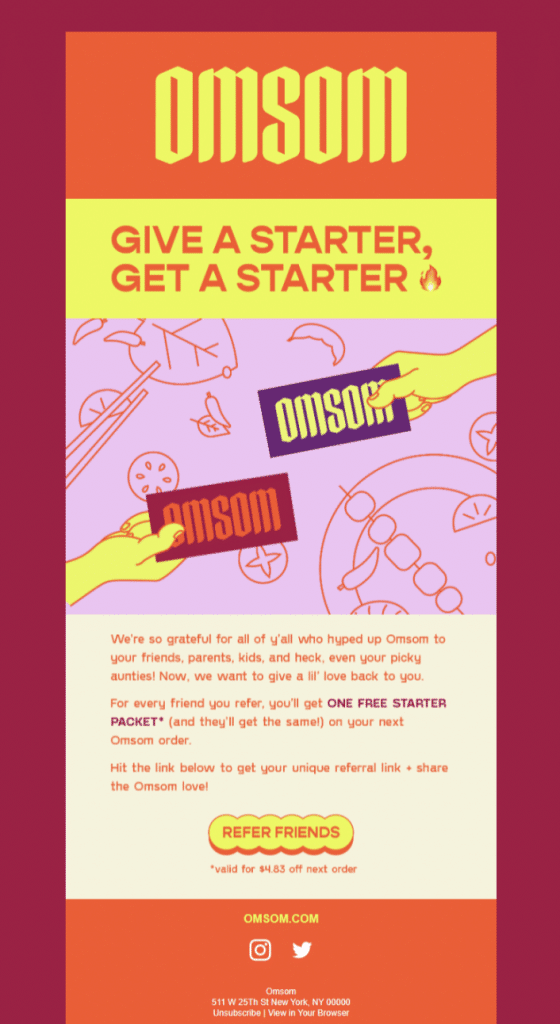

2. Referral program invite
The next step in the customer referral template process is to design the referral program invite. This invite will get potential advocates excited about your program and ready to refer friends. Your invite could be sent via email, social media, SMS, or any other digital method.
Referral invite templates: Essentials for all invites
What should you include in a referral invite? There are a few key pieces of information that are important to include, no matter which medium you use.
Your headline
Your headline draws customers in and tell them why they should stick around. Customers won’t read lengthy messages – they want to know what you’re about right from the get-go.
Include your headline in your subject line, or the first line of your invite, to keep them from clicking away or ignoring your message.
Why you’re contacting the customer
Think of your referral program invite as a job description for new hires. What do they need to know about the program? How can you “fill the open positions” for referral program advocates? Fill in the gaps, but don’t go overboard – keep things concise.
The benefit
What’s in it for your customers? Are there extrinsic rewards on offer? How about the intrinsic reward of helping a friend? The referral reward is sure to get customers’ attention.
A clear call-to-action
Close your message with an easy-to-find call-to-action, including an eye-catching button with a direct link to the referral program page. This will take your advocate exactly where they need to be, with no downtime and no waiting.
Referral email invites
Email is the most common way to send a referral program invite.
Besides the essentials for all invites, successful referral email invites include a few more key elements:
Referral invite emails should have a compelling subject line. Grab your readers’ attention and tell them what they need to know right off the bat.
Even if it’s already in the subject line, remind customers what they can get for sharing your brand. Start with your headline, then explain the rest toward the bottom of the page. It’s a great way to keep their interest and get them to read more.
Where possible, you should also include a thank you for your customer. If they purchased from you recently, left a positive review, or gave stellar comments to your customer service team, these are all great reasons to show appreciation. A simple but heartfelt thank you can do wonders for encouraging customer referrals.
Finally, it’s a best practice to include an eye-catching image. This creates a focal point that draws the customer in. Consider a hero image, which shows someone enjoying their reward.
Types of referral email invites
Take a look at these different kinds of email invites in order to find the best template for your referral program.
Personalized email invites
When individuals receive a personal email invite from your company, including their name and a custom message, they’re more likely to share your brand because they appreciate the time you took to write directly to them.
Given that, this type of message works especially well to invite your best customers to refer.
Email users and thank them for being loyal customers, remind them how you’ve helped them in the past, and ask if they know of anyone else who could benefit from your products or services.
A good time to send this email is a few days after a purchase, as customers see the value in your brand and have it top of mind.
Mass email invites
Mass emails are a great way to announce your referral program to all customers when it’s first launching, or tell all your customers when you’ve made any major changes to your program. This type of email is far less personal, but it’s a great way to quickly spread the word about your referral program.
When sending a mass email copy, include what the program involves, how customers can earn rewards, and how they can start sharing your brand with friends. You can even send them to a pre-launch page where they can sign up to be notified once the program is up and running. Or if you’ve already launched, point them toward your referral program page.
Re-engagement email invites
Re-engagement involves reaching out to a customer who might not have been active for a while. Sending them a text or email is a great way to get reacquainted and to see if they’re interested in your referral program. The email should let them know what they can earn and how to get started referring others.
Even if they choose not to join the referral program, it’s a great excuse to keep yourself top-of-mind and remind them to shop with a brand they love.
Indirect email invites
Indirect email invites include information about your brand that isn’t specific to the referral program. For instance, if you’re sending out info about a sale or a scheduled newsletter, you can include a CTA for the referral program. This is a smart way to plug your rewards program more subtly and keep it top-of-mind. Simply add a line or two about sharing, what customers can earn, and where to go in order to do so.
Check out how Casper plugs their referral program at the bottom of an email focused on reviews: “Give $50, Get $50. Refer friends and get rewards.”
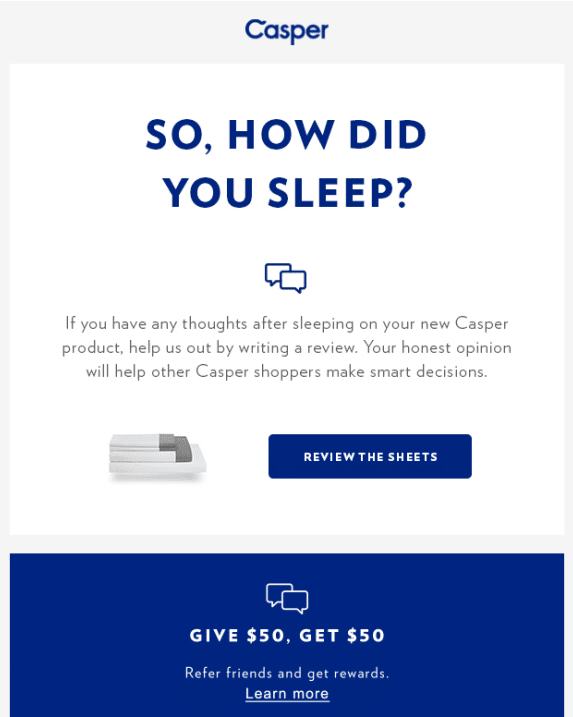
Invites in the invoice or receipt
Another way to use your customer referral program template is through an invoice or on a receipt. In a quick line, you can say something like “Ask us about our referral program” or “Share and earn free product.”
Your customer will see the message right after they’ve made a purchase, which is a great time to engage – they’re hyped up about your brand and will be more likely to spread the word.
You can also add a line or two about your business, or exactly what customers can earn, to further entice them to refer friends or family members.
Referral email invite examples
Take a look at these proven referral email examples for ideas you can incorporate into your own referral program template.
Bombas
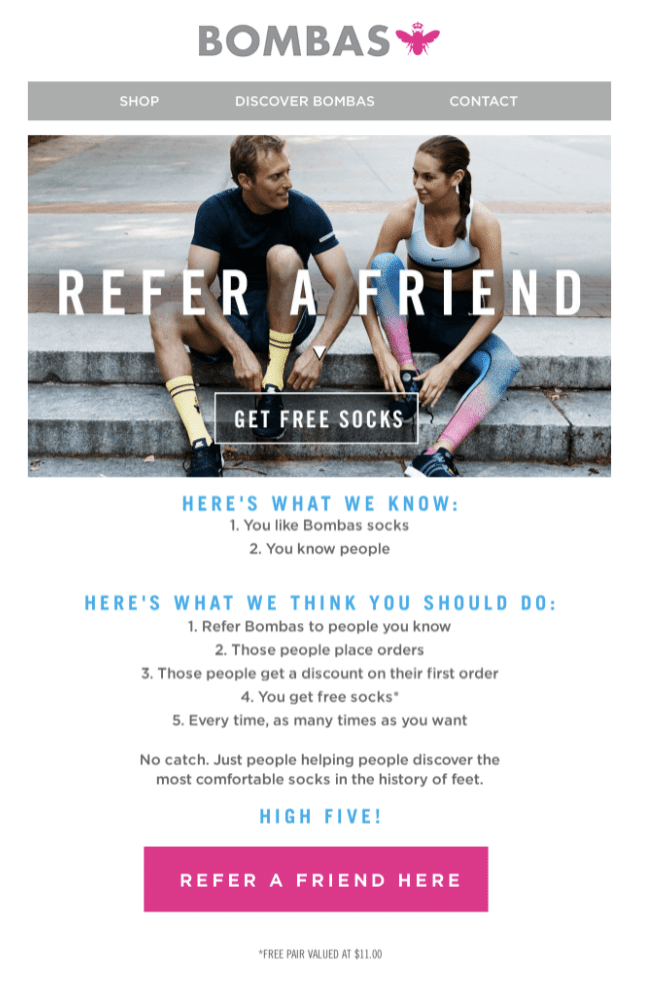
Bombas’ referral program email breaks things down into steps and shows that the referral program is easy for both the advocate and referred friend to use.
It tells what you get (free socks!) and how to get it (share with friends who place orders). Plus, it includes smart images of friends enjoying Bombas to support their message.
We also love the two call to action buttons: the “get free socks” one above the fold, and the eye-catching pink one at the bottom that reads “refer a friend here.”
Daily Harvest

Meanwhile, Daily Harvest uses colorful images of their box ingredients and step-by-step instructions, plus a bold call to action that invites advocates to “share $25.” Easy to read, easy to follow, easy to refer friends and earn.
Treehouse
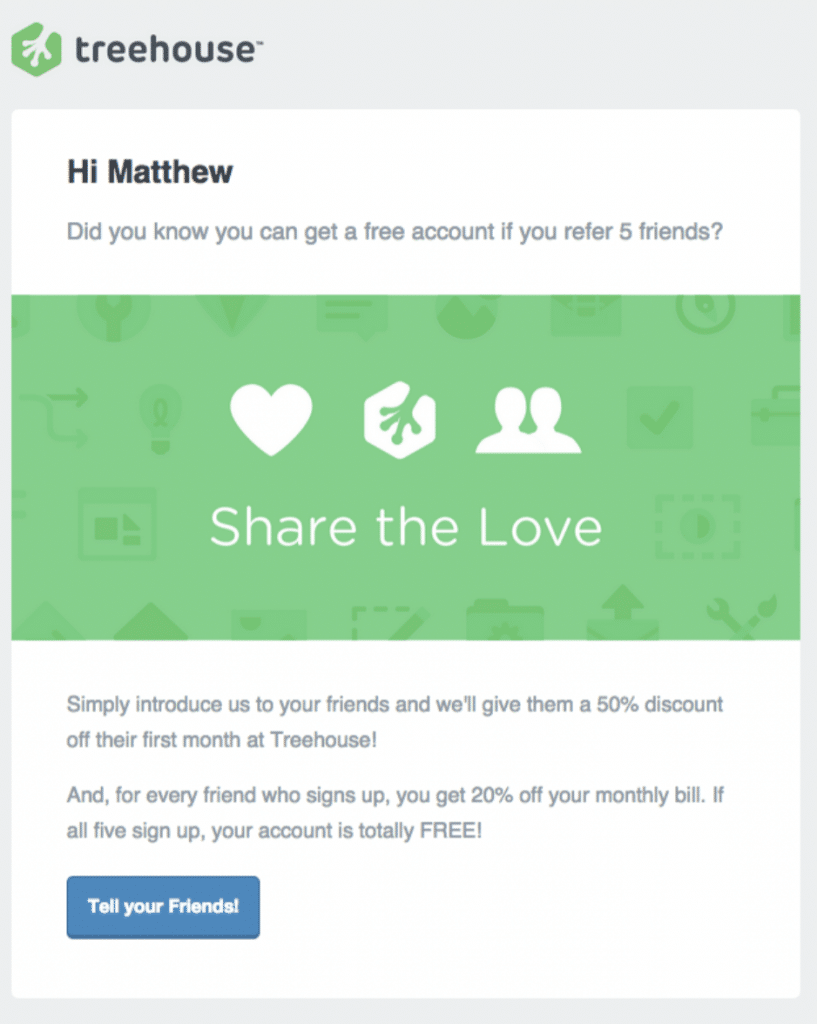
Treehouse offers a different kind of referral program, where customers can gain a stacking percentage discount on their bill for each new referral. If customers bring in five cumulative referrals, they eventually earn a free subscription.
Like the previous two examples, the Treehouse invite lays out all the program essentials in a way that’s easy to follow and engage with.
Social media referral invites
Use these social media best practices in order to create a smart and effective referral program invite. After all, social media is a great way to reach customers where they’re already spending time, without a big marketing budget. It’s a great way to grow your referral program and increase ROI, so be sure to include it in your referral program template.
● Use your headline: Optimize your headline to draw in users. Remind them what they can earn and how they can save with the help of your referral program. This is the first thing they will see, so make it count.
● Explain the program: Tell customers how your program works in a way that’s simple and effective. You don’t want them to search for the logistics, so spell it out in a way that makes sense, reads quickly, and focuses on their reward.
● Show what’s in it for the advocate: Let users know exactly what they’ll be getting when they provide a successful referral. Whether it’s a discount, money, or a free product, play it up so they’re intrigued.
● Change up your promotions regularly: Find new ways to entice your advocates by providing new rewards. You can try different options to see what interests them the most. If nothing else, a switch-up can reach new customers and get them to join in the fun.
● Use eye-catching images: Images are what will make your entire program pop. Be sure to include pictures that show excitement and express just what new and referring customers can gain out of the referral program.
● Directly link to your referral page/pop-up: Make it easy on your users and link them directly to the page. This eliminates any guesswork of where the user is supposed to land, and it increases sign up rates for the referral program.
Social media referral invite example: Booking.com
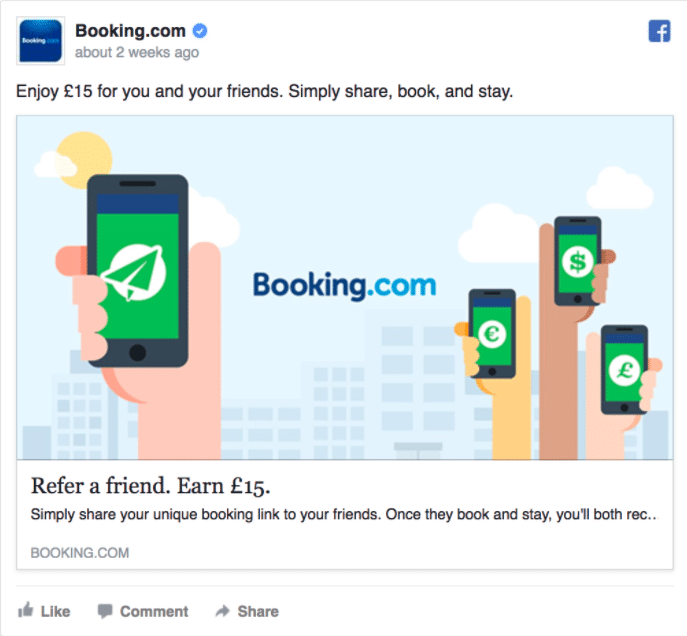
Booking.com draws customers in with an image of people earning money on their phones. Customers can see exactly what they can earn and give to their friends, and the image itself serves as a direct link to the referral program page. Plus, it’s easy for customers to know what to do: “Simply share, book, and stay.”
3. Referral program landing page (or pop-up)
The referral program landing page is the dedicated location on your website that advocates can access to refer friends.
You might have a platform where users have an account. In this case, you may decide that each user will be able to access their own referral program page when they’re logged in, and receive credit for all referrals that originate from this page.
However, this isn’t necessary. Many referral programs have a single page that handles all referral program traffic. In this case, every referrer then gets credit for referrals via their unique referral link.
The referral landing page is where your program invite sends your existing customers. Alternatively, the “page” can be a pop up on the website that users can click.
Referral program page template: What to include
There are a few key things that you should include on your referral program page. They include:
● Eye-catching headline: Grab your audience’s attention right from the get-go. Let them know what they can get, and how they can do it. Easy, exciting, and enticing.
● The motivating incentive: The incentive is what gets your current customers to sign up, and it’s what entices new customers to purchase from your brand. Make sure it’s prominently displayed on your program page.
● Short details about the program: How does the program work? How do customers refer friends? What do they get in return? Each of these questions should be answered clearly and easily on the page.
● Compelling imagery: Images are what make the sale. Use them to drum up excitement for your reward program and convince customers to earn the incentive.
● Terms and conditions: What must be done in order to earn the incentive? Is there a limit to referral rewards? Lay out the facts so customers know what to expect and how to earn their reward.
● Multiple options to refer friends: Allow your customers to reach friends in several ways, including email, social media, and a referral link. The more options you present for referring friends, the more referrals you’ll receive.
● (Bonus) FAQs, or a link to an FAQ page: This will lay out all the details for your customers, so they know exactly what to expect. It will also save your brand from responding to the same types of questions constantly. Plus, creating a separate FAQ will keep your referral page uncluttered.
● (Bonus) Testimonials: New advocates will want to know others have had a great experience with your referral program, and testimonials are an ideal way to prove this.
Don’t forget to optimize this page for mobile!
Referral program page examples
Take a look at these referral page templates and how they funnel customers through the program with their use of best practices.
MeUndies (referral page)
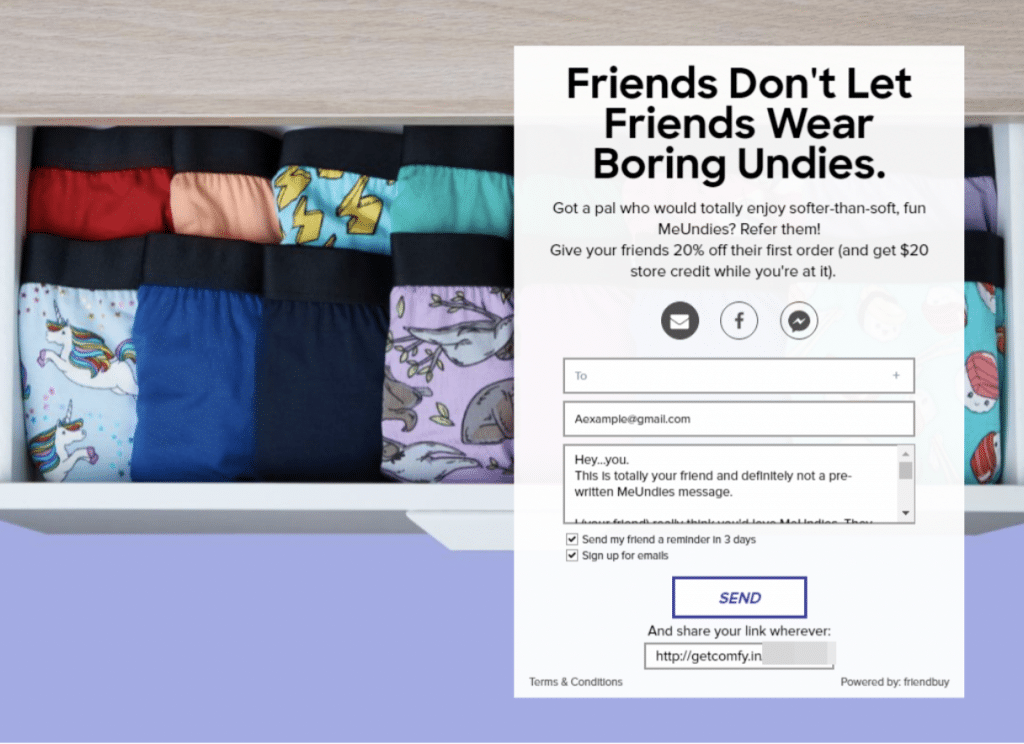
The MeUndies referral program page draws in the eye with a creative headline and an image of the reward – the undies you can get for free with store credit.
We also love how this referral landing page lets advocates customize their message to friends, and copy a referral link with one click for easy sharing.
Freshly (pop-up)
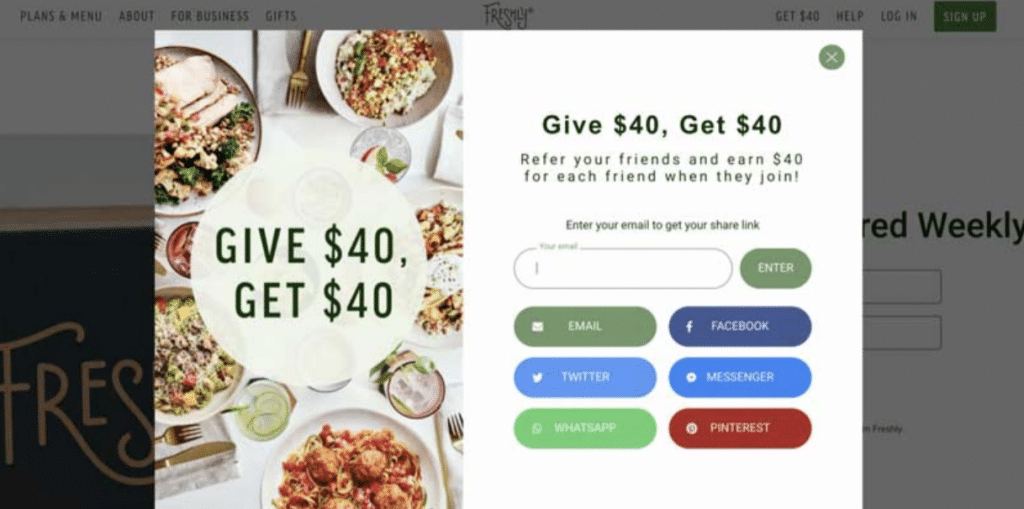
Freshly expertly uses an eye-catching headline, and enticing imagery, in their referral program pop-up. What really stands out, though, is the multiple sharing platforms involved in the program. Users can easily share their referral code in at least six different ways (email, Facebook, Messenger, Twitter, WhatsApp, and Pinterest). It’s a design that makes things simple for the referrer, and ensures they will find a platform that they readily use.
4. Referral message
The referral message is the message sent to the referred friend, directly from the advocate. It’s the friend’s first impression of your business, so make it good. It’s designed to get the new customer to check out your website, and hopefully to patronize your business too.
The message should feel casual, not salesy. Remember, this is coming from the advocate’s perspective, so it should be informal and friendly, not pushing an agenda.
A personalized referral message can provide some serious results. When individuals receive a message that addresses them by name, that is sent straight from a friend, and that is clearly customized for them – that means something.
It encourages potential customers to sign up and purchase at a rate much higher than with other methods, because they trust their friend. If you let the advocate actually write part of the message themselves, it tends to be even more effective.
Referral message template
Create your referral message template with a few easy steps.
- First, you can start with a fun or interesting note. This grabs readers’ attention and gets them to keep reading on.
- Next, ensure they know the message is from their peer. Include the right tone and wording, so they feel as though they’re talking to a friend, not a company.
- After that, show them who you are as a brand. The tone, images, and wording should all feel on-brand for your company, even though the message is from the advocate.
- Also, highlight the benefits of purchasing. What’s the reward they get for becoming a customer.
- Finally, close out with a clear CTA. Click Here. Sign up Now. Earn (reward). Or something along those lines, so new customers know exactly what to do next.
Referral message example: EveryPlate
In Everyplate’s referral message, the brand uses a light tone. EveryPlate draws the friend in with the incentive, mentions the advocate who referred them by name, and lays out the benefits of signing up for a subscription (“you decide, we deliver, you devour”).
Cooking references are included to stay on-brand, and imagery (including pictures of the reward the friend can earn) makes the entire thing come together. Finally, users are encouraged to claim their gift with a clearly marked CTA button.
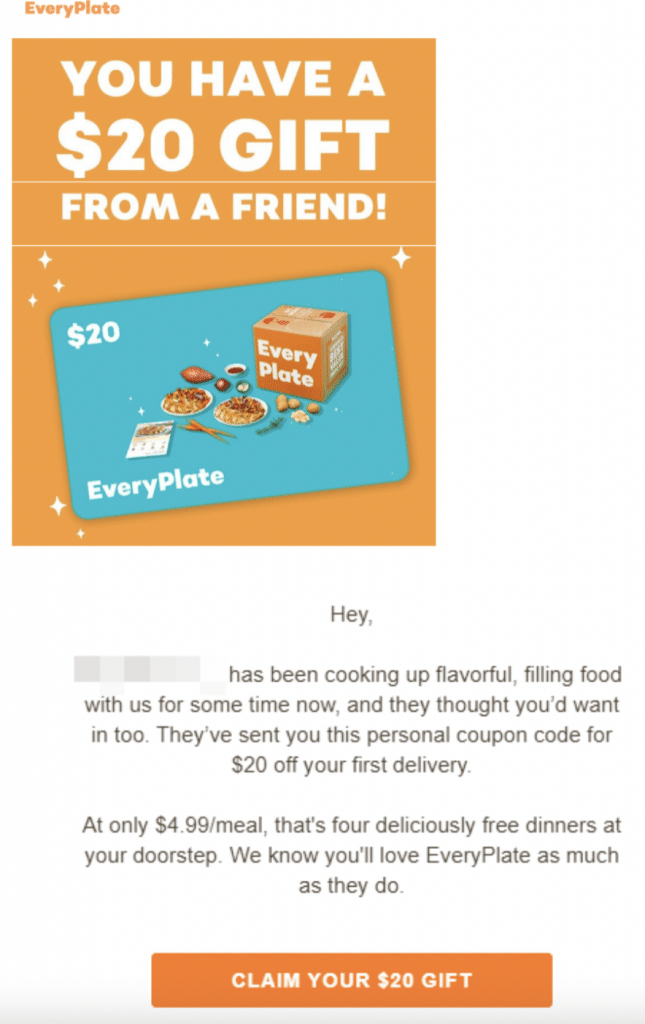
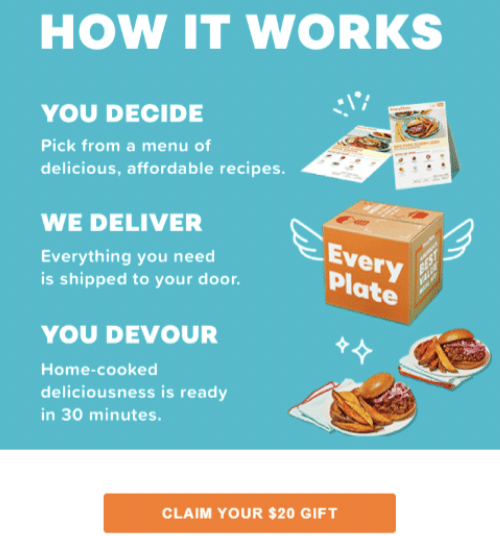
5. Friend landing page
The friend landing page is where the referred friend ends up after clicking the link in the referral message. It’s the first thing they see on your website.
How it looks will depend on your business and the type of action you want leads to take.
Friend landing page examples
Take a look at these landing page examples to see how these brands land more referral business through their website.
ColourPop

ColourPop goes all-out with a big, fun image. The other half of the page is dedicated to sharing the reward ($5 to shop), complimenting the advocate, and adding social and email links for the friend to create an account.
Morning Brew
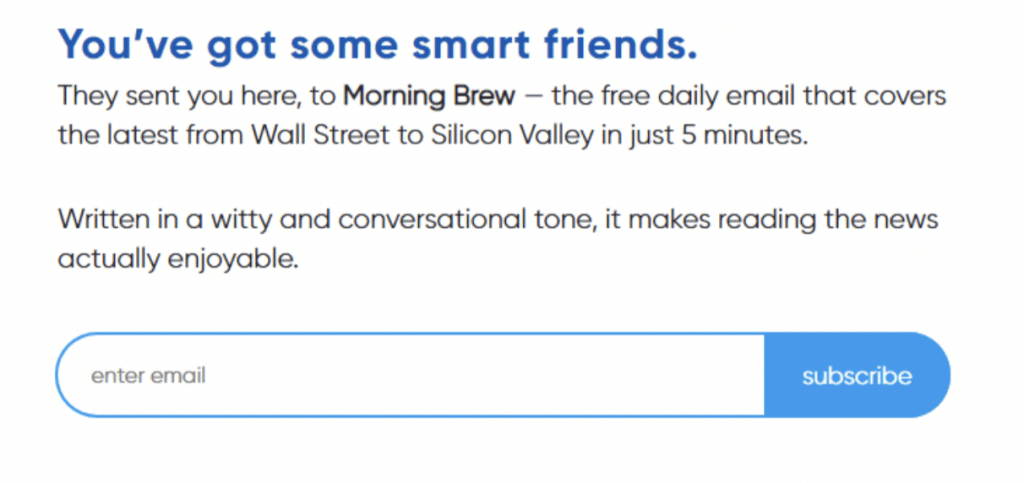
Meanwhile, the Morning Brew newsletter referral program keeps it simple. The brand also compliments the advocates, but then it jumps straight to the point. Users can enter their email, and done, they’re signed up to receive the Brew. A huge contact form leads them in the right direction, so there’s no missing the intended action.
Wrapping up: Create your own customer referral template
Create your own customer referral program template using the checklist included below.

To learn more about setting up your own referral program template, take a look at this guide for referral program ideas, and referral software that makes completing a customer referral program template easy.
